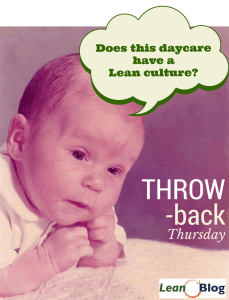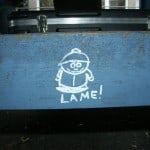 Today's post is a throwback to an essay that I originally wrote for the excellent book Lean-Led Hospital Design: Creating the Efficient Hospital of the Future
Today's post is a throwback to an essay that I originally wrote for the excellent book Lean-Led Hospital Design: Creating the Efficient Hospital of the Future, where it appears in an appendix with some other contributed essays.
You can listen to my podcast with the authors, Charles Hagood and Naida Grunden.
Reminder — check out the short reader survey at the bottom of this post and fill it out to have a chance to win a free book.
Here is the essay, with slight edits:
As simple and elegant as some Lean principles can be, the reality of putting these ideas into practice can be complex and challenging. While there are well-defined and generally accepted Lean principles, there is no single easy roadmap that shows you exactly how to apply these concepts and methods in a way that is guaranteed to succeed in every setting and every set of circumstances.
Because there is no single path for transforming an organization, there are different methods and approaches. Some organizations start their Lean journey by conducting dozens of weeklong improvement events as a way of demonstrating that change is possible. Others eschew events and start by engaging frontline staff members in small continuous improvements (what we would call “Kaizen” in the Lean framework).
There are different “flavors” of Lean transformation and the merits of these different approaches (and how best to combine them) can be debated respectfully amongst Lean professionals (and, sometimes, we end the discussion by agreeing to disagree). This post is not about criticizing any of those approaches. It is, however, a cautionary tale about avoiding approaches that violate any of these generally accepted core principles of Lean management.
People Can Call Anything “Lean” – But Shouldn't?
One challenge in the broader Lean community is that any leader in any organization can do anything, good or bad, and then label it as “Lean.” Early in their Lean journeys, too many organizations try to use a single Lean tool or concept in the context of their existing organizational culture. As the expression says, somebody might know “just enough about Lean to be dangerous.” Some of these misapplications of Lean are cases where people are trying hard, but they just don't know enough about Lean yet.
A few years back, I coined an admittedly awkward acronym – L.A.M.E. The acronym has a few different variations, including:
- Lean As Mistakenly Executed
- Lean As Misguidedly Explained
The acronym was inspired by reading a steady stream of articles (like this one) that described practices as “Lean,” but seemed to stray far from the true north of stated Lean and Toyota Production System principles. For example, if a writer described Lean as being “dehumanizing” or “turning people into robots,” it was likely a case where the writer had the completely wrong idea about Lean. Or, they were describing a sad scenario where, instead of embracing Lean as a holistic system, a few isolated Lean tools were being used with traditional and dysfunctional command-and-control mindsets.
Respect is Not Optional in Lean
The two pillars of “The Toyota Way” management philosophy are:
- Continuous Improvement
- Respect for People [i]
For practices to be truly Lean, leaders must practice both of these pillars. Former Toyota leader Gary Convis made it clear when he said that an environment for continuous improvement can “only be created where there is respect for people.” [ii] Taiichi Ohno, one of the creators of the Toytoa Production System described these as “equally important” pillars [iii]. Ignoring the “respect for people” principle is what usually leads to problems described as L.A.M.E.
As author and professor Bob Emiliani writes, “Real Lean” is a “non-zero-sum principle-based management system focused on creating value for end-use customers and eliminating waste, unevenness, and unreasonableness using the scientific method.” [iv] Emiliani also emphasizes that you must not just practice both pillars of the Toyota Way, but you must do so for the benefit of all stakeholders.
It's not Lean with Layoffs

Hospital leaders have, sadly, relied on layoffs and old-fashioned cost cutting for a long time, yet their efforts might get described in the news as “getting lean,” having nothing to do with the adoption of Toyota management methods. Or, hospital leaders might unfortunately use productivity improvements to directly drive layoffs, a result that is clearly a zero-sum game (the organization gains in the short-term, while the employees lose). Read about hospitals that take a “no layoffs” approach.
When organizations use Lean methods to drive layoffs, this would be an example of L.A.M.E., not Real Lean. Since Lean is based on Toyota's practices and philosophies, we should compare practices described as Lean to that dual ideal of continuous improvement AND respect for people. Is something only truly Lean if an organization or individual is being faithful to or building upon the traditions and mindsets of Toyota?
Toyota, as part of their “respect for people” philosophy, values their employees and chose to not lay off any permanent employees during even the worst of the post-financial crisis recession. Instead of taking short-term cost savings from layoffs (since, after all, they didn't need people to build cars and trucks for a period of time because not many were being sold), Toyota instead invested in their employees by paying them for training, education, and volunteer work in the community. Taking a long-term, win-win perspective, Toyota was not being charitable, they were investing in the future success of their factories and the company as a whole. After the 2011 Japan earthquake and tsunami disaster, GM laid off employees (L.A.M.E.) while Toyota invested in them (Lean), even though both companies had roughly the same amount of money in the bank at the time.
It's Not Lean if You Force Changes on People
Another way so-called Lean might really be L.A.M.E. is if changes are forced on people in a top-down way. A variation on this L.A.M.E.-ness can be found when the Toyota concept of “standardized work” is somehow translated into an inflexible, unchangeable “standard operating practice” that's forced on people by managers or outside experts.
Taiichi Ohno, one of the creators of the Toyota Production System, was quite clear in writing that people should create their own standardized work.[v] This is quite a break from the old approach of procedures being written by the boss or an expert (an idea that traces back more than 100 years to Frederick Taylor). A truly Lean environment is one where every employee has a voice in defining their standardized process in a way that best meets customer (patient) needs. Additionally, a truly Lean environment is one where everybody has a voice in improving the way work is done.
Could Checklists be Lame?
Look, for example, at the use of checklists to prevent surgical errors or central line infections, as demonstrated and advocated by Dr. Atul Gawande, Dr. Peter Pronovost, and the World Health Organization. Similar work was pioneered by Dr. Richard Shannon using Toyota and Lean methods as the model. The effective use of checklists has been demonstrated to virtually eliminate central line infections, but this success is characterized as a combination of the tool (the checklist or standardized work) and culture (how it was created and used). Checklists, as a close parallel to standardized work, can utilized in a way that demonstrates respect for people or, unfortunately, in a way that does not.
Checklists might be “L.A.M.E” (or its close equivalent) if they are forced on physicians by senior leaders. The Lean way would be to first collaborate with the physicians and other team members to define the problem and the need for improvement. They would then engage them in the creation of their own checklists.
I know one commercial airline pilot whose consulting group teaches hospitals how to guide people through the process of writing their own checklists. Not only does this demonstrate respect for people (Lean), it's more effective because people have a greater sense of ownership over something they have created. My pilot friend complains that a competing consulting firm will basically sell a hospital a pre-written checklist. It might seem like a reasonable time saver to “not reinvent the wheel,” but how do you think an off-the-shelf checklist that's forced on people is likely to be received? Which approach is more likely to have clinicians and caregivers fully engaged in continuous quality and patient safety improvement?
Lean Must Solve Meaningful Problems
Another example of L.A.M.E. is the use of Lean tools to address things that aren't the most pressing problems for patients or staff members. It has been demonstrated that a truly Lean environment can improve patient outcomes and quality, while reducing length of stay and creating a calmer, more fulfilling workplace for healthcare professionals. Lean methods should be used to solve important problems, of which hospitals have many.
One news story, from a few years back, featured complaints from nurses who said they were trying to engage their leaders in improving patient safety, yet were having their nurses' station micromanaged by managers and a central Lean department. The nurses were told they could only have two pens and two pencils at their desk, likely being told that anything more was “waste.” It's inexcusable to focus Lean “5S” practices on something as insignificant and inexpensive as a few pens, while patients are being harmed due to preventable falls and medication errors. This example illustrates the use of a tool, done in a top-down way, that “solves” something that wasn't a big problem to begin with – a perfect illustration of L.A.M.E. not Lean. Instead of thinking “what Lean tools should we use?” the question should be “what problems do we need to solve?”
Other Types of L.A.M.E.-ness
Another indicator of L.A.M.E. would be cases where “hands-off” senior leaders think that Lean is just a method that can be delegated to a quality department or that Lean methods only apply to front-line staff. Impressive and sustainable Lean results come from organizations where the CEO and leaders at all levels embrace Lean as a way of managing and a way of guiding daily decisions and improvement activities. Organizations like ThedaCare and Virginia Mason Medical Center have transformed their culture because Lean wasn't just a set of tools, nor was it just a bunch of projects.
As Lean becomes more popular in healthcare, there's a risk that the term becomes a buzzword and a marketing tool without much depth behind it. At this stage, I would bet most healthcare architects and construction companies would answer “yes” if asked by a client or owner “do you utilize Lean design and construction methods?” I've heard complaints from some hospitals that their architects could throw around the buzzwords, but then utilized the same old traditional design process. At the same time, I've heard an architect rightfully complain that some hospitals want them to design a “magically Lean building,” something that's not possible without the right effort from the hospital. As with checklists, Lean design has to be used in the right way – keeping “respect for people” at the forefront.
Can we absolutely determine of something is Lean or L.A.M.E.? There are some clear-cut cases where the approach being described as Lean violates a core principle or belief of the Toyota-based Lean approach. There are times, however, when it is a judgment call based on experience and there's room for disagreement. When is something L.A.M.E.? Repurposing a quote from the late U.S. Supreme Court Justice Potter Stewart, “I know it when I see it.”
References:
[i] Liker, Jeffrey K, The Toyota Way, xi.
[ii] Ibid
[iii] Ohno, Taiichi, Toyota Production System: Beyond Large-Scale Production, xiii.
[iv] Emiliani, Bob, Moving Forward Faster, 5.
[v] Ohno, 21.
Please scroll down (or click) to post a comment. Connect with me on LinkedIn.
Let’s build a culture of continuous improvement and psychological safety—together. If you're a leader aiming for lasting change (not just more projects), I help organizations:
- Engage people at all levels in sustainable improvement
- Shift from fear of mistakes to learning from them
- Apply Lean thinking in practical, people-centered ways
Interested in coaching or a keynote talk? Let’s talk.








